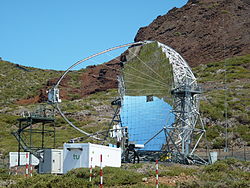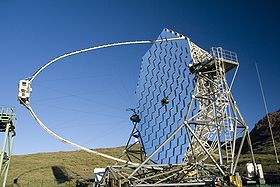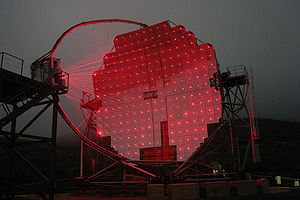- MAGIC (telescope)
-
This article is about the telescope. For other uses, see Magic (disambiguation).
MAGIC 1 The first MAGIC telescopeOrganization MAGIC collaboration Location La Palma, Canary Islands Altitude 2200 m Wavelength Gamma rays Built 2004 Telescope style Reflector Diameter 17m Collecting area 240 m² Focal length f/D 1.03 Mounting metal structure Website http://wwwmagic.mppmu.mpg.de/ MAGIC (Major Atmospheric Gamma-ray Imaging Cherenkov Telescopes) is a system of two Imaging Atmospheric Cherenkov telescopes situated at the Roque de los Muchachos Observatory on La Palma, one of the Canary Islands, at about 2200 m above sea level. MAGIC detects particle showers released by gamma rays, using the Cherenkov radiation, i.e., faint light radiated by the charged particles in the showers. With a diameter of 17 meters for the reflecting surface, it is the largest in the world.
The first telescope was built on 2004 and operated for five years in standalone mode. A second MAGIC telescope (MAGIC-II), at a distance of 85 m from the first one, started taking data in July 2009. Together they integrate the MAGIC telescope stereoscopic system.[1]
MAGIC is sensitive to cosmic gamma rays with energies between 50 GeV and 30 TeV due to its large mirror; other ground-based gamma-ray telescopes typically observe gamma energies above 200-300 GeV. Satellite-based detectors detect gamma-rays in the energy range from keV up to several GeV.
Contents
Aims
The goals of the telescope are to detect and study primarily photons coming from:
- Accretion of black holes in Active Galactic Nuclei
- Supernova remnants, due to their interest as sources of cosmic rays.
- Other galactic sources such as pulsar wind nebulae or X-ray binaries.[2][3]
- Unidentified EGRET or Fermi sources
- Gamma ray bursts
- Annihilation of Dark matter
Observations
MAGIC has found pulsed gamma-rays at energies higher than 25 GeV coming from the Crab Pulsar.[4] The presence of such high energies indicates that the gamma-ray source is far out in the pulsar's magnetosphere, in contradiction with many models.
MAGIC detected[5] very high energy cosmic rays from the quasar 3c 279, which is 5 billion light years from Earth. This doubles the previous record distance from which very high energy cosmic rays have been detected. The signal indicated that the universe is more transparent than previously thought based on data from optical and infrared telescopes.
MAGIC did not observe cosmic rays resulting from dark matter decays in the dwarf galaxy Draco.[6] This strengthens the known constraints on dark matter models.
A much more controversial observation is an energy dependence in the speed of light of cosmic rays coming from a short burst of the blazar Markarian 501 on July 9, 2005. Photons with energies between 1.2 and 10 TeV arrived 4 minutes after those in a band between .25 and .6 TeV. The average delay was .030±.012 seconds per GeV of energy of the photon. If the relation between the space velocity of a photon and its energy is linear, then this translates into the fractional difference in the speed of light being equal to minus the photon's energy divided by 2×1017 GeV.
Technical specifications
Each telescope has the following specifications:
- A collecting area 236 m² consisting of 50 cm x 50 cm Aluminium individual reflectors
- A lightweight carbon fibre frame
- A detector consisting of 396 separate hexagonal photomultiplier detectors in the center
(diameter: 2.54 cm) surrounded by 180 larger photomultiplier detectors (diameter: 3.81 cm).
- Data are transferred in analogue form by fibre optic cables
- Signal digitization is done via an ADC (analog-digital converter) of frequency 2 GHz
- Total weight of 40,000 kg
- Reaction time to move to any position of the sky less than 40 seconds
Collaborating Institutions
Physicists from over twenty institutions in Germany, Spain, Italy, Switzerland, Croatia, Finland, Poland, Bulgaria and Armenia collaborate in using MAGIC; the largest groups are at
- Institut de Física d'Altes Energies (IFAE)
- Universitat Autònoma de Barcelona, Spain
- Universidad Complutense Madrid,Spain
- Max-Planck-Institute for Physics, Munich, Germany
- Dipartimento di Fisica and INFN, University of Padua, Italy
- Tuorla Observatory, Piikkiö, Finland
- Dipartimento di Fisica and INFN, University of Siena, Italy
- Dipatimento di Fisica and INFN, University of Udine, Italy
- TU Dortmund University, Germany
- University of Würzburg, Germany
- Institute for Particle Physics, Zürich, Switzerland
- Institute for Nuclear Research and Nuclear Energy, Sofia, Bulgaria
- Croatian MAGIC Consortium (Institute Ruđer Bošković, Zagreb; University of Split, Split; University of Rijeka, Rijeka), Croatia
References
- ^ "Technical status of the MAGIC telescopes", MAGIC collaboration, Proc. International Cosmic Rays Conference 2009, arXiv:0907.1211
- ^ "Variable Very-High-Energy Gamma-Ray Emission from the Microquasar LS I +61 303", MAGIC collaboration, Science, 312, no. 5781 (2006) 1771
- ^ "Very High Energy Gamma-ray Radiation from the Stellar-mass Black Hole Cygnus X-1", MAGIC collaboration, Ap. J. 665 (2007) L51
- ^ "Observation of Pulsed Gamma-Rays Above 25 GeV from the Crab Pulsar with MAGIC", MAGIC collaboration, Science 322 (2008) 1221.
- ^ "Very-High-Energy gamma rays from a Distant Quasar: How Transparent Is the Universe?", MAGIC collaboration, Science 320 (2008) 1752
- ^ "Upper limit for gamma-ray emission above 140 GeV from the dwarf spheroidal galaxy Draco", MAGIC collaboration, Astrophys. J. 679, 428 (2008)
External links
Categories:- Gamma-ray telescopes
- La Palma
Wikimedia Foundation. 2010.




